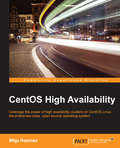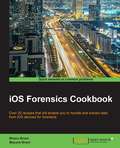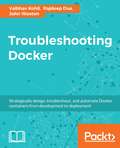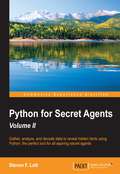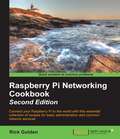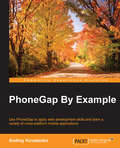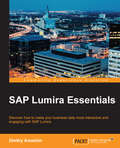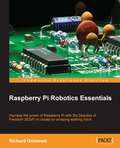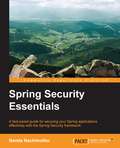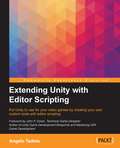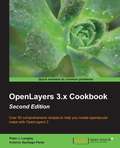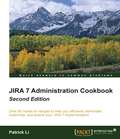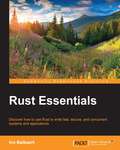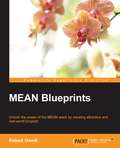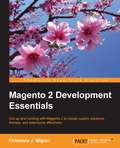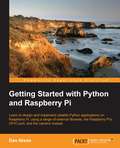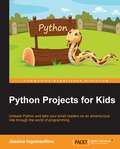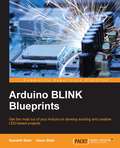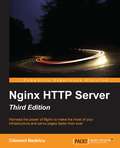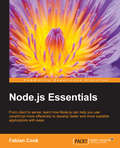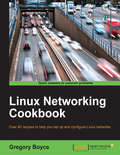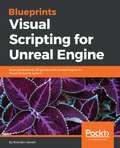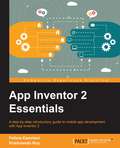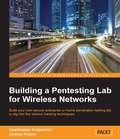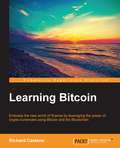- Table View
- List View
CentOS High Availability
by Mitja ResmanThis book is targeted at system engineers and system administrators who want to upgrade their knowledge and skills in high availability and want to learn practically how to achieve high availability with CentOS Linux. You are expected to have good CentOS Linux knowledge and basic networking experience.
iOS Forensics Cookbook
by Bhanu Birani Mayank BiraniOver 20 recipes that will enable you to handle and extract data from iOS devices for forensics About This Book * This book gets you straight into solving even the most complex iOS forensic problems with easy-to-understand recipes * Get to grips with extraction and analysis techniques to perform forensic investigations on iOS devices * Gain insights into how to protect your data and perform data recovery from iOS-based devices Who This Book Is For If you are an iOS application developer who wants to learn about a test flight, hockey app integration, and recovery tools, then this book is for you. This book will be helpful for students learning forensics, as well as experienced iOS developers. What You Will Learn * Discover the various ways to save data in the document directory of the device * Get to grips with encrypting and decrypting of files saved in the document directories * Explore ways to integrate social media with iOS applications * Grab the user events and actions on the iOS application using analytic tools * Analyze useful information from the data gathered in the cloud * Grasp numerous concepts associated with air application distribution * Track errors in an application effectively to document them for forensic analysis * Read crash reports accumulated on iTunesConnect and decode them to generate and gather useful information In Detail Mobile device forensics is a branch of digital forensics that involves the recovery of evidence or data in a digital format from a device without affecting its integrity. With the growing popularity of iOS-based Apple devices, iOS forensics has developed immense importance. To cater to the need, this book deals with tasks such as the encryption and decryption of files, various ways to integrate techniques with social media, and ways to grab the user events and actions on the iOS app. Using practical examples, we'll start with the analysis keychain and raw disk decryption, social media integration, and getting accustomed to analytics tools. You'll also learn how to distribute the iOS apps without releasing them to Apple's App Store. Moving on, the book covers test flights and hockey app integration, the crash reporting system, recovery tools, and their features. By the end of the book, using the aforementioned techniques, you will be able to successfully analyze iOS-based devices forensically. Style and approach This book takes a step-by-step recipe-based approach to iOS forensics and investigation techniques. Topics are explained sequentially in order of complexity, and are accompanied by code and theory that is easy to grasp.
Troubleshooting Docker
by Rajdeep Dua Vaibhav Kohli John WootenStrategically design, troubleshoot, and automate Docker containers from development to deployment About This Book • Utilize current and emergent technologies for effective Docker orchestration and management • A step-by-step guide to diagnosing and fixing problems with Docker containers. Who This Book Is For This book is intended for seasoned solutions architects, developers, and programmers, system engineers, and administrators to help you troubleshoot common areas of Docker containerization. If you are looking to build production-ready Docker containers for automated deployment, you will be able to master and troubleshoot both the basic functions and the advanced features of Docker. Advanced familiarity with the Linux command line syntax, unit testing, the Docker Registry, Github, and leading container hosting platforms and Cloud Service Providers (CSP) are the prerequisites. What You Will Learn • Install Docker ecosystem tools and services, Microservices and N-tier applications • Create re-usable, portable containers with help of automation tools • Network and inter-link containers • Attach volumes securely to containers • Consume and troubleshoot Docker APIs • Troubleshooting issue of Docker deployment in Public cloud • Ease the process of container management with Kubernetes In Detail This book will traverse some common best practices to for complex application scenarios where troubleshooting can be successfully employed to provide the repeatable processes and advantages that containers can deliver. This book will be a practical guide showing how to fix real-life issues related to installation, memory, Dockerfile syntax, connection, authorization, networking and so on in Docker. This book will also teach how to solve errors that occur during advanced setup and administration and deployment in a step-by-step fashion. By sequentially working through the real-world production scenarios in each chapter throughout the book, you will gain insight into and mastery of common areas not only for effective troubleshooting, but ways and means to avoid troubleshooting in the first place. This book will also cover tips and tricks that make the workflow easier. Style and approach An easy-to-follow guide full of interactive examples of real-world development and deployment scenarios. Ample screenshots, workflows, complementary tools, and related terminal commands are provided to address a wide range of practical and situational applications.
Python for Secret Agents - Second Edition
by Steven F. LottThis book is for Secret Agents who have some exposure to Python. Our focus is on the Field Agents who are ready to do more sophisticated and complex programming in Python. We'll stick to simple statistics for the most part. A steady hand with a soldering iron is not required, but a skilled field agent should be able to assemble a working Arduino circuit to gather their own sensor data.
Raspberry Pi Networking Cookbook - Second Edition
by Rick GoldenThis book is intended for students, scientists, and hobbyists who wish to connect their Raspberry Pi to other devices on a local area network or to the Internet of Things. Whether you are new to the Raspberry Pi, or already have a lot of experience with it, the recipes in this book will be a valuable reference to you and inspire your next project. You will want to have this book handy as a guide whenever you are working on networking projects for the Raspberry Pi.
PhoneGap By Example
by Andrey KovalenkoUse PhoneGap to apply web development skills and learn variety of cross-platform mobile applications About This Book * Utilize the robust features of the mobile hybrid approach to develop, test, and publish mobile applications using the PhoneGap framework * Use your web skills for hybrid mobile application development and deliver to many mobile platforms without rewriting the code * Develop a set of ready-to-use mobile applications with this practical, comprehensive, step-by-step guide Who This Book Is For If you are a web developer with some experience in development of single page applications and want to enter the world of mobile applications, then this technology and book is ideal for you. Since PhoneGap maintains an incredibly easy-to-use plugin interface, no previous experience in native languages development (such as Objective-C or Java) is required. What You Will Learn * Set up plugins to access the camera and filesystem to capture media * Build a custom RESTful service and integrate it with a PhoneGap application * Integrate a HTML5 Canvas element to create mobile games * Build scalable applications using a modern mobile web framework * Interact with RESTful services from a mobile application * Build an audio/video chat facility using the PhoneGap and WebRTC technologies * Develop a PhoneGap plugin with native interfaces for iOS In Detail PhoneGap is a free and open source framework that allows you to create mobile apps using standardized web APIs for the platforms you care about. It is one of the first and fastest spreading tools to develop hybrid applications using CSS, JavaScript, and HTML, without losing the advantages of native applications. If you are already a web developer, this book will provide you with the skills you need to create, customize, test, and deploy hybrid mobile applications. Starting from the beginning, this book will cover how to set up your PhoneGap development environment, add mobile web frameworks and plugins, design and customize the application layout, and utilize the embedded features of the PhoneGap framework. By working through the steps in each chapter, you will quickly master a variety of mobile applications with totally different approaches. You will then learn how to develop a PhoneGap plugin with native interfaces for iOS and Android, as well as common approaches to test PhoneGap applications. With ample screenshots that show you how to build a phenomenal application, PhoneGap by Example will ensure your success with this cutting-edge mobile development framework for hybrid applications. Style and approach An easy-to-follow guide packed with hands-on examples of real-world mobile applications. Each topic is explained sequentially in the process of creating a hybrid mobile application, and detailed explanations of the basic and advanced features of PhoneGap are included.
SAP Lumira Essentials
by Dmitry AnoshinDiscover how to make your business data more interactive and engaging with SAP Lumira About This Book * Create a powerful data discovery experience with the advanced capabilities of SAP Lumira * Find business insights in your data through data blending, wrangling, transformation, and visualization * A fast-paced guide packed with hands-on practical examples, real-world solutions, and best practices to get you started with SAP Lumira Who This Book Is For If you are a SAP user, business analyst, BI developer, or a junior data engineer who wants to use SAP Lumira to build creative visualizations, this book is for you. You should have a reasonable level of knowledge of SAP Business Objects and its components. What You Will Learn * Deploy SAP Lumira on your computer and learn more about the SAP Lumira interface * Extract data from different sources using SAP Lumira's data connecters * Prepare, filter, clean, and format your data * Discover visualization techniques and data discovery methods * Administrate and customize SAP Lumira to get basic knowledge of its SDK * Create various charts to deliver fantastic data visualizations * Connect to SAP BusinessObjects BI Platform and SAP HANA to extract, prepare, and visualize data In Detail SAP Lumira allows you to combine data from multiple sources into a single view and create engaging visualizations quickly and easily. It is a reporting platform that helps users access data and independently perform analysis. With the increasing interest in data discovery, self-service BI, and visualization around the world, tools like SAP Lumira help to eliminate the complexities of analyzing and discovering data. Learn data discovery techniques, build amazing visualizations, create fantastic stories, and share your visualizations through an electronic medium with one of the most powerful tools around--SAP Lumira. You will begin with an overview of the SAP Lumira family of products. You will then go through various data discovery techniques using real-world scenarios of an online e-commerce retailer through detailed recipes on the installation, administration, and customization of SAP Lumira. Next, you will work with data, starting from acquiring data from various data sources, then preparing and visualizing it using the rich functionality of SAP Lumira. Finally, you will present data via a data story or infographic and publish it across your organization or on the World Wide Web. Style and approach This is a step-by-step guide to learning SAP Lumira essentials packed with examples on real-world problems and solutions.
Raspberry Pi Robotics Essentials
by Richard GrimmettIf you are a programmer with an interest in building advanced robotics projects using inexpensive hardware and open source software, then this book is for you. Some experience with computer programming and implementing simple mechanical systems is required.
Spring Security Essentials
by Nanda NachimuthuA fast-paced guide for securing your Spring applications effectively with the Spring Security frameworkAbout This BookExplore various security concepts using real-time examples of the Spring Security frameworkLearn about the functionalities that implement industry standard authentication and authorization mechanisms to secure enterprise-level applicationsDesign and develop advanced Spring Security layers by following a step-by-step approachWho This Book Is ForIf you are a developer who is familiar with Spring and you are looking to explore its security features, then this book is for you. All beginners and experienced users will benefit from this book since it is explores both the theory and practical usage in detail.What You Will LearnSee industry standard security implementations in actionUnderstand the principles of security servers, concepts, installation, and integrationUse Spring Extensions for various security mechanismsGet to grips with the internals of the tools and servers involved in the security layerWork through practical projects and working programsCompare different security servers and techniquesUse the sample projects in practical, real-time applicationsGet further readings and guidance on advanced security mechanismsIn DetailSpring Security is a framework that focuses on providing both authentication and authorization to Java applications. Like all Spring projects, the real power of Spring Security is how easily it can be extended to meet custom requirements. The popularity of the Spring framework is increasing and the security package of Spring addresses vast mechanisms of Security in a rich way. Due to an increasing number of applications for various business needs, the integration of multiple applications is becoming inevitable. The standard security procedures available across multiple implementations in Spring will protect vulnerable applications that are open to larger public and private audiences.Spring Security Essentials focuses on the need to master the security layer, which is an area not often explored by a Spring developer.At the beginning, we'll introduce various industry standard security mechanisms and the practical ways to integrate with them. We will also teach you about some up-to-date use cases such as building a security layer for RESTful web services and applications.The IDEs used and security servers involved are briefly explained, including the steps to install them. Many sample projects are also provided to help you practice your newly developed skills. Step-by-step instructions will help you master the security layer integration with the Server, then implement the experience gained from this book in your own real-time application.Style and approachThis practical guide is packed with detailed explanations of the underlying concepts, as well as screenshots and working examples that guarantee hands-on learning.
Extending Unity with Editor Scripting
by Angelo TadresPut Unity to use for your video games by creating your own custom tools with editor scripting About This Book * Acquire a good understanding of extending Unity's editor capabilities for a platformer game by using Gizmos, custom inspectors, editor windows, scriptable objects, and more * Learn to configure and get control over your asset import pipeline using asset preprocessors * A step-by-step, comprehensible guide to creating and customizing a build pipeline that fits the necessities of your video game development team Who This Book Is For This book is for anyone who has a basic knowledge of Unity programming using C# and wants to learn how to extend and create custom tools using Unity editor scripting to improve the development workflow and make video game development easier. What You Will Learn * Use Gizmos to create visual aids for debugging * Extend the editor capabilities using custom inspectors, property and decorator drawers, editor windows, and handles * Save your video game data in a persistent way using scriptable objects * Improve the look and feel of your custom tools using GUIStyles and GUISkins * Configure and control the asset import pipeline * Improve the build creation pipeline * Distribute the custom tools in your team or publish them in the Asset Store In Detail One of Unity's most powerful features is the extensible editor it has. With editor scripting, it is possible to extend or create functionalities to make video game development easier. For a Unity developer, this is an important topic to know and understand because adapting Unity editor scripting to video games saves a great deal of time and resources. This book is designed to cover all the basic concepts of Unity editor scripting using a functional platformer video game that requires workflow improvement. You will commence with the basics of editor scripting, exploring its implementation with the help of an example project, a level editor, before moving on to the usage of visual cues for debugging with Gizmos in the scene view. Next, you will learn how to create custom inspectors and editor windows and implement custom GUI. Furthermore, you will discover how to change the look and feel of the editor using editor GUIStyles and editor GUISkins. You will then explore the usage of editor scripting in order to improve the development pipeline of a video game in Unity by designing ad hoc editor tools, customizing the way the editor imports assets, and getting control over the build creation process. Step by step, you will use and learn all the key concepts while creating and developing a pipeline for a simple platform video game. As a bonus, the final chapter will help you to understand how to share content in the Asset Store that shows the creation of custom tools as a possible new business. By the end of the book, you will easily be able to extend all the concepts to other projects. Style and approach This book uses a step-by-step approach that will help you finish with a level editor tool, a custom configuration for the asset import pipeline, and a build pipeline totally adjusted to the video game.
OpenLayers 3.x Cookbook - Second Edition
by Antonio Santiago Perez Peter J. LangleyOver 50 comprehensive recipes to help you create spectacular maps with OpenLayers 3 About This Book * Create highly customized mapping apps for the web with rich interactivity and diverse content using JavaScript * See how successful mapping apps work and how they integrate with third-party services * Packed full of code examples, screenshots, and explanations from professionals in the industry Who This Book Is For If you are a GIS-related professional with basic knowledge of web technologies and want to gain in-depth knowledge of creating web mapping applications, then this book is for you. The recipes will be appropriately mixed to suit JavaScript beginners or experts and cover basic to advanced topics on OpenLayers. What You Will Learn * Create stunning maps, and understand projection. * Add customized raster and vector layers * Work with important tile providers * Work with OGCs, WMS, and WFS compliant servers * Read/write features from/to different data sources * Style features to improve their visualization * Understand events and work with the main controls * Enhance maps with HTML5 technologies such as Geolocation In Detail Data visualization and analytics has become an important task across all technology-based industries. OpenLayers 3,is one of the most important and complete open source JavaScript mapping libraries today. Throughout this book, you will go through recipes that expose various features of OpenLayers 3, allowing you to gain an insight into building complex GIS web applications. You'll get to grips with the basics of creating a map with common functionality and quickly advance to more complicated solutions that address modern challenges. You will explore into maps, raster and vector layers and styling in-depth. This book also includes problem solving and how-to recipes for the most common and important tasks. The range of recipes includes: creating basic maps, working with raster and vector layers, understanding events,working with the main controls, reading features from different data sources, styling features, and understanding the underlying architecture. It will also cover solutions and optimizations to challenges commonly faced in modern applications. Style and approach This book teaches you how to create stunning maps that are highly interactive and visually appealing with the help of 50 handpicked recipes. Each recipe will address your need to visualize data on a map. Just follow the steps in the recipes to create maps of your choice in no time.
JIRA 7 Administration Cookbook - Second Edition
by Patrick LiOver 80 hands-on recipes to help you efficiently administer, customize, and extend your JIRA 7 implementation About This Book * Make JIRA adapt to your organization and process flow * Gather and display the right information from users with customized forms and layouts * Extend the capabilities of JIRA with add-ons, scripts, and integrations with other popular applications and cloud platforms * Use JIRA Service Desk as a customer service support portal Who This Book Is For This book is for administrators who customize, support, and maintain JIRA for their organization. What You Will Learn * Customize basic settings for your projects, such as screens and fields * Create and customize workflows to suit your business process needs * Make workflows more effective and efficient * Manage users and groups inside JIRA and manage advanced login options * Secure your JIRA instance using effective practices * Perform e-mail functionalities with JIRA * Extend JIRA to integrate with other products and services In Detail JIRA 7 Administration Cookbook, Second Edition covers all the new major features that provide better prioritizing capabilities, enhanced visibility, and the ability to customize JIRA application to meet your needs. We start by upgrading your existing JIRA instance and working through tasks you can perform at the server level to better maintain it. We then delve deep into adapting JIRA to your organization's needs, starting with the visual elements of setting up custom forms to capturing important data with custom fields and screens, and moving on to ensuring data integrity through defining field behaviors. You'll gain insights into JIRA's e-mail capabilities, including managing outgoing e-mail rules and processing incoming e-mails for automated issue creation. The book contains tips and tricks that will make things easier for you as administrators, such as running scripts to automate tasks, getting easy access to logs, and working with tools to troubleshoot problems. The book concludes with a chapter on JIRA Service Desk, which will enable you to set up and customize your own support portal, work with internal teams to solve problems, and achieve optimized services with SLA. Style and approach This recipe-based book allows administrators to explore the exciting capabilities of JIRA. After reading this book, you will be able to extend and customize your JIRA implementation.
Rust Essentials
by Ivo BalbaertThis book is intended for software developers interested in systems level and application programming, and are looking for a quick entry into using Rust and understanding the core features of the framework. It is assumed that you have a basic understanding of Java, C#, Ruby, Python or JavaScript.
M.E.A.N. Blueprints
by Robert OnodiIf you are a web developer with a basic understanding of the MEAN stack, experience in developing applications with JavaScript, and basic experience with NoSQL databases, then this book is for you.
Magento 2 Development Essentials
by Fernando J. MiguelGet up and running with Magento 2 to create custom solutions, themes, and extensions effectively About This Book * Create unique solutions for Magento 2 by developing and implementing solutions, themes, and extensions * Be proficient in the main functionalities, resources, and system structure of Magento 2 * Get to grips with this practical and hands-on guide to raise your web development skills to the next level Who This Book Is For If you are a PHP developer who wants to improve your skills in e-commerce development by creating themes and extensions for Magento 2, then this book is for you. What You Will Learn * Install and set up the Magento Ecosystem * Choose the best options for Magento's Sell System features * Work with Search Engine Optimization in Magento * Create and customize themes for Magento * Develop extensions for new Magento functionalities * Package extensions to publish in the Magento Connect network * Create Magento solutions for mobile devices * Carry out performance adjustments to speed up your Magento system In Detail Magento is the e-commerce software and platform trusted by the world's leading brands. Used by thousands of merchants for their transactions worth billions, it provides the flexibility to customize the content and functionality of your website. By strengthening your fundamentals in Magento development, you can develop the best solutions and take advantage of the growing market. This fast-paced tutorial will provide you with skills you need to successfully create themes, extensions, and solutions to Magento 2 projects. This book begins by setting up Magento 2 before gradually moving onto setting the basic options of the Sell System. You will take advantage of Search Engine Optimization aspects, create design and customize theme layout, develop new extensions, and adjust the Magento System to achieve great performance. By sequentially working through the steps in each chapter, you will quickly explore all the features of Magento 2 to create a great solution. With ample examples and a practical approach, this book will ensure your success with this astonishing e-commerce management system. Style and approach This book would be a fast-paced tutorial guide that uses hands-on examples to developing new solutions for Magento e-commerce system. Each topic is explained sequentially in the process of creating a Magento solution, along with detailed explanations of the basic and advanced features of Magento 2.
Getting Started with Python and Raspberry Pi
by Dan NixonLearn to design and implement reliable Python applications on the Raspberry Pi using a range of external libraries, the Raspberry Pis GPIO port, and the camera module About This Book * Learn the fundamentals of Python scripting and application programming * Design user-friendly command-line and graphical user interfaces * A step-by-step guide to learning Python programming with the Pi Who This Book Is For This book is designed for those who are unfamiliar with the art of Python development and want to get to know their way round the language and the many additional libraries that allow you to get a full application up and running in no time. What You Will Learn * Fundamentals of Python applications * Designing applications for multi-threading * Interacting with electronics and physical devices * Debugging applications when they go wrong * Packaging and installing Python modules * User interface design using Qt * Building easy to use command-line interfaces * Connecting applications to the Internet In Detail The Raspberry Pi is one of the smallest and most affordable single board computers that has taken over the world of hobby electronics and programming, and the Python programming language makes this the perfect platform to start coding with. The book will start with a brief introduction to Raspberry Pi and Python. We will direct you to the official documentation that helps you set up your Raspberry Pi with the necessary equipment such as the monitor, keyboard, mouse, power supply, and so on. It will then dive right into the basics of Python programming. Later, it will focus on other Python tasks, for instance, interfacing with hardware, GUI programming, and more. Once you get well versed with the basic programming, the book will then teach you to develop Python/Raspberry Pi applications. By the end of this book, you will be able to develop Raspberry Pi applications with Python and will have good understanding of Python programming for Raspberry Pi. Style and approach An easy-to-follow introduction to Python scripting and application development through clear conceptual explanations backed up by real-world examples on the Raspberry Pi.
Python Projects for Kids
by Jessica IngrassellinoUnleash Python and take your small readers on an adventurous ride through the world of programming About This Book * Learn to start using Python for some simple programming tasks such as doing easy mathematical calculations. * Use logic and control loops to build a nice interesting game. * Get to grips with working with data and, once you're comfortable with that, you'll be introduced to Pygame, which will help you wrap up the book with a cool game. Who This Book Is For This book is for kids (aged 10 and over). This is book is intended for absolute beginners who lack any knowledge of computing or programming languages and want to get started in the world of programming. What You Will Learn * Start fiddling with Python's variables, build functions and interact with users * Build your own calculator using the Math Library * Train Python to make logical decisions * Work with moving 2D objects on-screen * Understand the Pygame Library and build your very own game! * Write a cool program to manage inventories in your backpack In Detail Kids are always the most fast-paced and enthusiastic learners, and are naturally willing to build stuff that looks like magic at the end (when it works!). Programming can be one such magic. Being able to write a program that works helps them feel they've really achieved something. Kids today are very tech-savvy and cannot wait to enter the fast-paced digital world. Because Python is one of the most popular languages and has a syntax that is quite simple to understand, even kids are eager to use it as a stepping stone to learning programming languages. This book will cover projects that are simple and fun, and teach kids how to write Python code that works. The book will teach the basics of Python programming, installation, and so on and then will move on to projects. A total of three projects, with each and every step explained carefully, without any assumption of previous experience. Style and approach The book will take a light approach in guiding the little readers through the world of Python. The main idea is to teach by example and let the readers have as much exercises to do, so that they learn faster and can apply their own ideas to the existing examples. The book should get them thinking, by the end, on where they can go next with such a powerful tool at their disposal.
Arduino BLINK Blueprints
by Samarth Shah Utsav ShahAnyone with a basic computer knowledge should be able to get the most out of this book. Although familiarity with some of the electronics would be helpful, it is not a must.
Nginx HTTP Server - Third Edition
by Clement NedelcuHarness the power of Nginx to make the most of your infrastructure and serve pages faster than ever About This Book * Discover possible interactions between Nginx and Apache to get the best of both worlds * Learn to exploit the features offered by NGinx for your web applications * Get the newest techniques available, designed with the latest version in mind Who This Book Is For By covering both the early setup stages and advanced topics, this book suits web administrators who interested in solutions to optimize their infrastructure, whether you are looking into replacing your existing web server software or integrating a new tool to cooperate with applications that are already up and running. If you, your visitors, and your operating system have been disappointed by Apache, this book is exactly what you need. What You Will Learn * Get to know the basics of the Nginx configuration: syntax, structure, and semantics * Understand the advanced load balancing functionality of Nginx and the newest innovative IO mechanisms * Create virtual host configurations effortlessly * Discover all the first-party modules: how to enable, configure, and use them * Establish advanced rewrite rules with the Nginx Rewrite module * Set up Nginx to work with PHP, Python, and more via FastCGI * Configure Nginx to work as frontend for your existing HTTP server * Manipulate configuration files with ease and adapt them to various situations * Discover the common pitfalls and find out how to avoid them In Detail Nginx is a lightweight HTTP server designed for high-traffic websites, with network scalability as the primary objective. With the advent of high speed Internet access, short loading times and fast transfer rates have become a necessity. This free, open source solution will either come as a full replacement of other software such as Apache, or stand in front of your existing infrastructure to improve its overall speed. This book is a detailed guide to setting up Nginx in different ways that correspond to actual production situations: as a standalone server, as a reverse proxy, interacting with applications via FastCGI, and more. In addition, this complete directive reference will be your best friend at all stages of the configuration and maintenance processes. This book is the perfect companion for both Nginx beginners and experienced administrators. For beginners, it will take you through the complete process of setting up this lightweight HTTP server on your system and configuring its various modules so it does exactly what you need quickly and securely. For more experienced administrators, this book provides different approaches that can help you make the most of your current infrastructure. Nginx can be employed in many situations, whether you are looking to construct an entirely new web-serving architecture or simply want to integrate an efficient tool to optimize your site loading speeds. Style and approach This tutorial-style book includes detailed instructions on each of the processes it describes, as well as step-by-step tutorials, commented configuration sections, and in-depth module descriptions, so you can make the most of the performance potential offered by Nginx.
Node.js Essentials
by Fabian CookFrom client to server, learn how Node.js can help you use JavaScript more effectively to develop faster and more scalable applications with easeAbout This BookDiscover how Node.js can transform the way you develop both the front and back ends - offering a much more modern and integrated form of web developmentCreate, debug, and test a complete full-stack application using Node.js and other powerful toolsFrom creating a server from scratch to unit testing code, learn how Node.js extends the possibilities of JavaScript developmentWho This Book Is ForIf you want to expand your capabilities as a developer this book is for you. Covering everything you need to use Node.js effectively, you will soon be able to handle JavaScript in a much more fully-realised way.What You Will LearnCreate and use an HTTP server using Express.jsConfigure environmental variables, arguments, and config filesUse a Key/Value NoSQL database with Node to store dataCreate a client-side application using Node and Node.WebkitDebug applications using Node.InspectorCreate a library that can be used in more than one projectInstall packages from NPMIn DetailNode.js is simply a tool that lets you useJavaScript on the server side. But it actually does much more than that - by extending JavaScript it allows for a much more integrated and efficient approach to development. It's no surprise that it's a fundamental tool for full-stack JavaScript developers. Whether your working on the back end or front end - by using Node.js you're adopting a much more collaborative and agile way of working - so you and your team can focus on delivering a quality end product. This will ensure you're ready to take on any new challenges that get thrown at you.NodeJS Essentials takes you through the fundamentals of Node.JS and demonstrates how Node.js can transform the way you work with JavaScript and take greater control over your code.You will also learn how to create a HTTP server from scratch, route requests, create a RESTful interface, and authenticate users. You will also learn to debug applications using Node.Inspector and the importance of logging, as well as creating a reusable library.Finally, you'll find out how to test and optimizr your code when working with Node.js using the Mocha framework. Follow each step and discover how to test both synchronous and asynchronous code using Mocha unit tests.With Node.js Essentials you'll find everything you need to create a complete full-stack application with Node.js. It will help you harness JavaScript much more effectively - and in doing so expand your confidence and capabilities as a developer.Style and approachThis concise guide will help you get up and running with Node.js. Packed with easy to followexamples, you'll be be able to build a complete full-stack application utilizing Node's capabilities.
Linux Networking Cookbook
by Gregory BoyceThis book is targeted at Linux systems administrators who have a good basic understanding and some prior experience of how a Linux machine operates, but want to better understand how various network services function, how to set them up, and how to secure them. You should be familiar with how to set up a Linux server and how to install additional software on them.
Blueprints Visual Scripting for Unreal Engine
by Brenden Sewell<P><P>Blueprints Visual Scripting for Unreal Engine is a step-by-step approach to building a fully functional game, one system at a time. Starting with a basic First Person Shooter template, each chapter will extend the prototype to create an increasingly complex and robust game experience. You will progress from creating basic shooting mechanics to gradually more complex systems that will generate user interface elements and intelligent enemy behavior. Focusing on universally applicable skills, the expertise you will develop in utilizing Blueprints can translate to other types of genres. <P><P>By the time you finish the book, you will have a fully functional First Person Shooter game and the skills necessary to expand on the game to develop an entertaining, memorable experience for your players. <P><P>From making customizations to player movement to creating new AI and game mechanics from scratch, you will discover everything you need to know to get started with game development using Blueprints and Unreal Engine 4.
App Inventor 2 Essentials
by Krishnendu Roy Felicia KamrianiA step-by-step introductory guide to mobile app development with App Inventor 2 About This Book * Get an introduction to the functionalities of App Inventor 2 and use it to unleash your creativity * Learn to navigate the App Inventor platform, develop basic coding skills and become familiar with a blocks based programming language * Build your very first mobile app and feel proud of your accomplishment * Follow tutorials to expand your app development skills Who This Book Is For App Inventor 2 Essentials is for anyone who wants to learn to make mobile apps for Android devices - no prior coding experience is necessary. What You Will Learn * Perform technical setup and navigate the App Inventor platform * Utilize the interactive development environment by pairing a mobile device with a computer using Wi-Fi or USB * Build three apps: a game, an event app and a raffle app * Create the user interface of the app in the Designer and program the code in the Blocks Editor * Integrate basic computer science principles along with more complex elements such fusion tables and lists * Test and troubleshoot your applications * Publish your apps on Google Play Store to reach a wide audience * Unleash your creativity for further app development In Detail App Inventor 2 will take you on a journey of mobile app development. We begin by introducing you to the functionalities of App Inventor and giving you an idea about the types of apps you can develop using it. We walk you through the technical set up so you can take advantage of the interactive development environment (live testing). You will get hands-on, practical experience building three different apps using tutorials. Along the way, you will learn computer science principles as well as tips to help you prepare for the creative process of building an app from scratch. By the end of the journey, you will learn how to package an app and deploy it to app markets. App Inventor 2 Essentials prepares you to amass a resource of skills, knowledge and experience to become a mobile app developer Style and approach Every topic in this book is explained in step-by-step and easy-to-follow fashion, accompanied with screenshots of the interface that will make it easier for you to understand the processes.
Building a Pentesting Lab for Wireless Networks
by Vyacheslav Fadyushin Andrey PopovIf you are a beginner or a security professional who wishes to learn to build a home or enterprise lab environment where you can safely practice penetration testing techniques and improve your hacking skills, then this book is for you. No prior penetration testing experience is required, as the lab environment is suitable for various skill levels and is used for a wide range of techniques from basic to advance. Whether you are brand new to online learning or you are a seasoned expert, you will be able to set up your own hacking playground depending on your tasks.
Learning Bitcoin
by Richard CaetanoEmbrace the new world of fiance by leveraging the power of crypto-currencies using Bitcoin and the BlockchainAbout This BookSet up your own wallet, buy and sell Bitcoin, and execute custom transactions on the BlockchainLeverage the power of Bitcoin to reduce transaction costs and eliminate fraudA practical step-by-step guide to break down the Bitcoin technology to ensure safe transactionsWho This Book Is ForIf you are familiar with online banking and want to expand your finances into a resilient and transparent currency, this book is ideal for you. A basic understanding of online wallets and financial systems will be highly beneficial to unravel the mysteries of Bitcoin.What You Will LearnSet up your wallet and buy a Bitcoin in a flash while understanding the basics of addresses and transactionsAcquire the knack of buying, selling, and trading Bitcoins with online marketplacesSecure and protect your Bitcoins from online theft using Brainwallets and cold storageUnderstand how Bitcoin's underlying technology, the Blockchain, works with simple illustrations and explanationsConfigure your own Bitcoin node and execute common operations on the networkDiscover various aspects of mining Bitcoin and how to set up your own mining rigDive deeper into Bitcoin and write scripts and multi-signature transactions on the networkExplore the various alt-coins and get to know how to compare them and their valueIn DetailThe financial crisis of 2008 raised attention to the need for transparency and accountability in the financial world. As banks and governments were scrambling to stay solvent while seeking a sustainable plan, a powerfully new and resilient technology emerged.Bitcoin, built on a fundamentally new technology called "The Blockchain," offered the promise of a new financial system where transactions are sent directly between two parties without the need for central control.Bitcoin exists as an open and transparent financial system without banks, governments, or corporate support. Simply put, Bitcoin is "programmable money" that has the potential to change the world on the same scale as the Internet itself.This book arms you with immense knowledge of Bitcoin and helps you implement the technology in your money matters, enabling secure transactions.We first walk through the fundamentals of Bitcoin, illustrate how the technology works, and exemplify how to interact with this powerful and new financial technology. You will learn how to set up your online Bitcoin wallet, indulge in buying and selling of bitcoins, and manage their storage. We then get to grips with the most powerful algorithm of all times: the Blockchain, and learn how crypto-currencies can reduce the risk of fraud for e-commerce merchants and consumers.With a solid base of Blockchain, you will write and execute your own custom transactions. Most importantly, you will be able to protect and secure your Bitcoin with the help of effective solutions provided in the book. Packed with plenty of screenshots, Learning Bitcoin is a simple and painless guide to working with Bitcoin.Style and approachThis is an easy-to-follow guide to working with Bitcoin and the Blockchain technology. This book is ideal for anyone who wants to learn the basics of Bitcoin and explore how to set up their own transactions.
